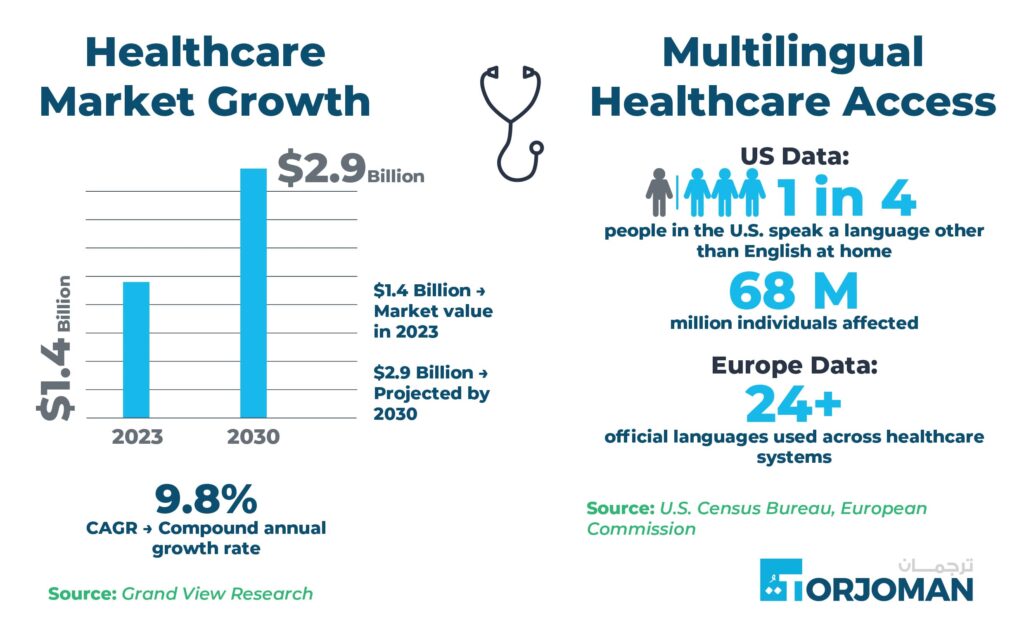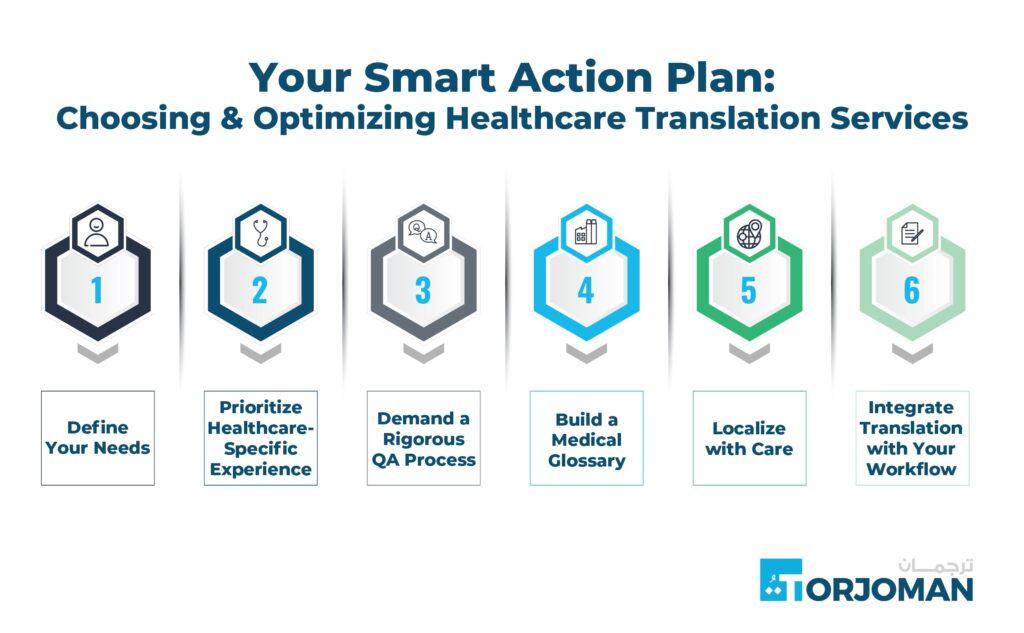Have a Big Project?
Big numbers, lots of documents and multiple translations?
Our top performing teams deliver unmatched quality on time for you
to hit your business goals.

The healthcare ecosystem is becoming increasingly global, and professional healthcare translation services are becoming more essential than ever.
In this blog post, you’ll discover why healthcare translation services are essential for safe, compliant, and culturally competent care. How to deliver better care, reduce risk, and meet compliance through expert language services
We are almost halfway through 2025, and although the global healthcare landscape is increasingly complex, it is full of opportunity.
Global healthcare providers are expanding services across borders. But successful expansion depends on overcoming one critical hurdle: language. Whether it’s communicating with patients, healthcare professionals, or regulatory bodies, effective translation is non-negotiable.
The market for healthcare translation services is growing rapidly:
Why the surge?
Healthcare providers investing in language precision are setting new standards for equity, trust, and reduced risk.
Let’s be honest—if your hospital or clinic isn’t offering professional language support, you’re putting both patients and your organization at risk.
Think about this: A 2018 study found that only 56% of U.S. hospitals offered any form of language or interpreter services. Other sources place that number only slightly higher, around 60–70%. That leaves up to 40% of facilities without adequate coverage.
If you’re in that group, it’s time for a serious conversation.

Now consider this: in the U.S., over 25 million people are classified as Limited English Proficient (LEP). These are patients who may not fully understand their diagnosis, consent forms, or treatment plans without help, and far too often, they’re treated without a qualified interpreter.
As a healthcare provider, you already know what that means:
And yes—legal exposure, too. Under Title VI, HIPAA, and various accreditation standards like JCI, you’re obligated to provide meaningful access to care in the patient’s preferred language. Failing to do so doesn’t just put lives at risk—it puts your entire operation in jeopardy.
But beyond compliance and liability, there’s something even more foundational at stake: trust. When a patient feels misunderstood, fragmented, or lost in translation, they disengage. You lose not just that patient, but their long-term loyalty—and maybe even your community’s confidence.
Here’s the truth: accurate, accessible language support is essential. For patient safety. For operational integrity. For trust.
Even with the best intentions, hospitals often face significant hurdles when implementing translation services. The complexity of medical terminology, strict regulatory requirements, and the urgency of patient care make accurate translation a high-stakes task.
Many healthcare settings struggle with inconsistent quality, a lack of qualified interpreters, and systems that don’t integrate language support smoothly into clinical workflows. On top of that, cultural nuances and patient trust can be easily compromised when translations fall short.
Understanding these challenges is the first step toward building a language access strategy that protects both patients and providers. Here are five major challenges hospitals must navigate:
Choosing the right healthcare translation company isn’t just a matter of compliance—it’s a strategic decision that directly affects patient care, safety, and your healthcare organization’s reputation.
In a complex healthcare setting, where precision and clarity are critical, working with a generalist translation company can lead to serious risks. The translation of medical content requires much more than language fluency—it demands deep knowledge of medical terminology, regulatory standards, and the unique needs of both medical professionals and patients.
This is why it’s essential to partner with a provider that specializes in healthcare language translation services. An expert healthcare translator brings more than words—they offer a full suite of language translation services for healthcare, backed by domain-specific experience and a robust quality assurance process.
Whether you’re translating medical records, consent forms, clinical trials, or video translation services in healthcare, your provider must understand the context, not just the content.
A professional partner will also ensure compliance with HIPAA, Title VI, and Joint Commission standards, while supporting cultural accuracy and sensitivity. They should offer qualified interpreters, certified linguists, and scalable solutions for both document and video translation services, especially for telehealth and real-time patient interactions. Whether you’re in the U.S. or seeking medical translation services in Dubai, accuracy, confidentiality, and cultural fluency are non-negotiable.
But selecting the right provider is just the beginning. To truly optimize your investment, follow this smart action plan:

1. Define Your Needs
Outline the medical documents, platforms, or touchpoints you need translated, such as document translations for patients, digital content, or app-based services for improving patient communication.
2. Prioritize Healthcare-Specific Experience
Choose a company with proven success in healthcare professionals translation, ISO certifications, and HIPAA compliance.
3. Demand a Rigorous QA Process
Ensure your provider uses multi-step review—especially important for sensitive content like medical records and consent forms.
4. Build a Medical Glossary
Collaborate on a custom list of clinical terms and brand language to maintain consistency in every accurate translation.
5. Localize with Care
Adapt content to each audience’s culture and health literacy—crucial for improving patients’ experience.
6. Integrate Translation with Your Workflow
Select a provider who can work within your EMR, CMS, or telehealth systems—streamlining delivery and maintaining accuracy at scale.
By working with an expert in healthcare translation services, you’re not just translating—you’re building trust, improving outcomes, and delivering better, safer care.
With over 20 years of specialization in medical translation, Torjoman provides:
Partner with Torjoman to elevate patient trust, drive compliance, and support global growth.
Interested? Contact Torjoman today.
How big is the healthcare translation services market?
As of 2023, the global healthcare translation services market is valued at approximately USD 1.45 billion. It’s projected to reach USD 2.55 billion by 2030, growing at a compound annual growth rate (CAGR) of 8.4%.
This growth is fueled by increasing demand for multilingual healthcare access, the rise of telemedicine and digital health platforms, and regulatory requirements for language access in patient care.
(Grand View Research – Life Sciences Translation Services Market Report)
How many hospitals offer professional language services?Studies show fewer than 60–70% of U.S. hospitals consistently offer interpreter services, leaving many LEP patients unsupported.(PMC, Lippincott Journals, bioethics.umn.edu)
Do hospitals benefit from VRI?
Yes—a major U.S. system cut interpreter wait times by 78% and saw comprehension improve by over 30% thanks to video interpreting.
Can machine translation suffice?
Not on its own. While machine translation tools (like Google Translate) can be useful for quick, informal communication, they are not reliable enough for medical use where accuracy, clarity, and patient safety are critical.
Even small translation errors can lead to misdiagnoses, consent issues, or treatment mistakes.
That’s why healthcare organizations should use machine translation only with professional post-editing—a process where qualified medical translators review and correct the output. This ensures the final content meets the high standards required in clinical, legal, and patient communication contexts.
What should I look for in a translation provider?
Look for healthcare domain experts, ISO-certified workflows, HIPAA or CLAS compliance, mix of services (document + interpreting), and tech integration with your clinical systems.
Conclusion
Healthcare is global—and language should be a bridge, not a barrier. By investing in precise, culturally competent translation and interpretation services, you’re doing more than translating words. You’re building trust, reducing risk, and delivering better outcomes.
Invest in trusted translation. Invest in patient trust.
Big numbers, lots of documents and multiple translations?
Our top performing teams deliver unmatched quality on time for you
to hit your business goals.
Ready to burst your borders and need work done quickly?
Order Now! To get an instant assessment and quote.
Don’t wait, we’re ready.
SAVE TIME & MONEY!
Order from our mobile app now